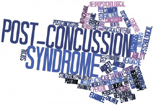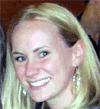
The vast majority of concussion symptoms will resolve
quickly with proper treatment. Approximately 80-90% of
patients experience improvement in symptoms in 7-10 days
after injury. Unfortunately, 1-5% of patients with
concussions will still be symptomatic after one month (5).
Physical therapists can play a vital role in the treatment
of post-concussive syndrome (PCS), especially for those
patients experiencing persistent or severe headaches,
dizziness, and balance impairments.
Between 23-81% of people will experience dizziness, or
altered balance and coordination after a concussion (1). In
most cases, these symptoms will improve with rest, though a
subset of patients with prolonged symptoms may benefit from
vestibular physical therapy. Patients may not explicitly
report “dizziness” and may describe their symptoms using
other terms including:
- feeling off balance
- vertigo
- light headedness or fogginess
- spinning of either self or environment
- nausea
- sensation of motion (1)
The vestibular system, including the inner ear and its
connections to the brain, is responsible for stabilizing
visual images on the retina during head movement,
maintaining postural stability, and provides information for
spatial orientation (6). As a result, vestibular dysfunction
can significantly impair a patient’s ability to function in
daily life and return to school, work, athletics, and other
activities.
Initially, a physical therapist needs to determine the cause
of symptoms. Vestibular symptoms following a concussion may
be due to a myriad of causes such as:
- inner ear disorders - benign paroxysmal positional vertigo
(BPPV), labyrinthine concussion, perilymphatic fistula
- central nervous system dysfunction - post-traumatic
migraine, brainstem concussion, autonomic dysregulation/postural
hypotension, oculomotor abnormalities, seizures
- musculoskeletal disorders - cervicogenic dizziness (8)
A thorough neurological examination is warranted, including
assessment of cranial nerves, myotomes, dermatomes, muscle
stretch/deep tendon reflexes and other tests to rule out
other more severe neurological involvement, such as
Hoffman’s, Babinski, rapid alternating movements, and clonus.
Patients often demonstrate postural instability with balance
tests such as the
Sensory Organization Test (SOT),
Clinical Test for
Sensory Interaction in Balance (CT-SIB), the
Balance Error
Scoring System (BESS),
Dynamic Gait Index, or
Functional
Gait Assessment. Physical therapists or other health care
providers may utilize tests such as the
Dix-Hallpike and
Horizontal
Roll Tests to assess the semi-circular canals for
the presence of BPPV and treat appropriately.
In addition, a vision assessment should be done. The eyes
provide visual input to the brain and vestibular systems to
allow for maintenance of balance and postural stability.
Following a concussion, patients often have difficulty with
gaze stabilization, leading to feelings of dizziness with
movements of the eyes or the head. They will often report
dizziness with reading, taking notes from the board in
class, or walking through hallways or store aisles. A
patient with a concussion may demonstrate spontaneous or
gaze-evoked nystagmus, or have difficulty or reproduction of
symptoms with the vestibulo-ocular reflex (VOR) smooth
pursuit and saccadic eye movements.
Other than with treatment for BPPV, the goal of vestibular
rehabilitation is to facilitate central nervous
compensation, rather than truly altering the vestibular
system (3). Literature regarding vestibular rehabilitation
specifically following concussion is currently sparse, but
is gradually increasing with the growing concern and
interest in the treatment of PCS. Alsalaheen et al. reported
improvement in gait and balance with vestibulo-ocular reflex
(VOR-1) exercises and balance training in patients with
persistent symptoms following a concussion (1). VOR
exercises generally begin with fixing eyes on a stationary
target on a blank background and shaking head left and right
or up and down while keeping the target focused. Patients
often fatigue quickly and may have an increase in symptoms
if progressed too quickly, so speed, duration and frequency
are slowly increased up to 1-2 minutes, performed 2-5 times
per day. As patient improves, the exercise may be progressed
with a more distracting background, such as a checkerboard,
or with dynamic activities such as walking (7). Patients may
also benefit from smooth pursuit or saccadic exercises.
Balance can be challenged with decreasing base of support,
progressing to a softer surface or with eyes closed, and
moving from static to dynamic activities. Patient
demonstrating difficulty with convergence-divergence of the
eyes may initially have difficulty with tossing and catching
a ball, which can be used as an exercise. As a patient
improves, physical therapists can get creative with
vestibular and gaze stabilization exercises, involving more
dynamic activities that can ease return to sport, such as
core rotations or cone touches with reach with varying
points of focus.
Persistent headaches are the most commonly reported symptom
of post-concussive syndrome (8). Patients may have symptoms
consistent with cervicogenic headaches, migraine, combined
migraine and cervicogenic headaches, or secondary to
cognitive fatigue. Currently, literature specifically
tailored to the treatment of post-concussion related
headaches is lacking, so it is suggested that management is
based on primary headache categories and treatment (8).
Physical therapists should do a thorough subjective and
objective examination to determine the source of headache
symptoms. Given the trauma often present with a concussion,
patients may demonstrate symptoms consistent with whiplash
and associated disorders (WAD) that may cause cervicogenic
headaches. Physical therapists should address range of
motion, cervicothoracic mobility, scapular stabilizer and
deep neck flexor strength and endurance, and for the
presence of muscular dysfunction and trigger points.
Cervical mobility, pain, and function often needs to be
addressed before a patient is able to progress with VOR
exercises.
Immediately following a concussion, there is a period of
physical and cognitive rest to allow for the brain to return
to homeostasis. Exercise too soon after injury may prolong
recovery (4). Once a patient is symptom-free at rest, the
five-step return to activity protocol may begin. For
patients experiencing persistent symptoms at three weeks or
more, initial exercise assessment and gradually increasing
aerobic exercise at a subsymptomatic threshold may assist
with recovery (2). More research needs to be done, though
early studies are promising.
With the frequency of concussions and the potential for
long-lasting symptoms, research continues to be needed
regarding the treatment of PCS. Early studies do indicate
that patients with persistent symptoms may benefit from
physical therapy and current concussion management
recommendations reflect this. As a result, proper and timely
referral to physical therapists experienced with
rehabilitation of PCS may assist with improvement of
symptoms and return to daily function.
Click here to return to "The Role of the Physical Therapist
When Working With Patients With Post-Concussive Syndrome -
(Part 1)"
Last revised: April 15, 2013
by Lauren Hogan, PT, DPT, ATC
References
1) Alsalaheen, B. a, Mucha, A., Morris, L. O., Whitney, S.
L., Furman, J. M., Camiolo-Reddy, C. E., Collins, M. W., et
al. (2010). Vestibular rehabilitation for dizziness and
balance disorders after concussion. Journal of neurologic
physical therapy : JNPT, 34(2), 87–93.
doi:10.1097/NPT.0b013e3181dde568
2) Baker, J. G., Freitas, M. S., Leddy, J. J., Kozlowski, K.
F., & Willer, B. S. (2012). Return to full functioning after
graded exercise assessment and progressive exercise
treatment of postconcussion syndrome. Rehabilitation
research and practice, 2012, 705309. doi:10.1155/2012/705309
3) Herdman, S. J. (1997). Advances in the treatment of
vestibular disorders. Physical therapy, 77(6), 602–18.
Retrieved from http://www.ncbi.nlm.nih.gov/pubmed/9184686
4) Leddy, J. J., Kozlowski, K., Fung, M., Pendergast, D. R.,
& Willer, B. (2007). Regulatory and autoregulatory
physiological dysfunction as a primary characteristic of
post concussion syndrome: implications for treatment.
NeuroRehabilitation, 22(3), 199–205. Retrieved from http://www.ncbi.nlm.nih.gov/pubmed/17917170
5) McCrory, P., Meeuwisse, W., Johnston, K., Dvorak, J.,
Aubry, M., Molloy, M., & Cantu, R. (2009). Consensus
Statement on Concussion in Sport: the 3rd International
Conference on Concussion in Sport held in Zurich, November
2008. British Journal of Sports Medicine, 43(Suppl 1),
i76–i84. doi:10.1136/bjsm.2009.058248
6) O’Sullivan, S. B., & Schmitz, T. J. (2007). Physical
Rehabilitation (2007th ed., pp. 1000–1030). Philadelphia:
Jaypee Brothers.
7) Ryan, J. J. (2012). The Neurovestibular Complex - CEU &
Course Materials. The Neurovestibular Complex - CEU & Course
Materials. Chicago: Therapy Network Seminars. Retrieved from
http://www.tnseminars.com/courses/the-neuro-vestibular-complex
8) Stewart, G. W., Mcqueen-borden, E., Bell, R. A., Barr,
T., & Juengling, J. (2012). Comprehensive Assessment and
Management of Athletes with Sport Concussion. International
Journal of Sports Physical Therapy, 7(4), 433–448.
|







